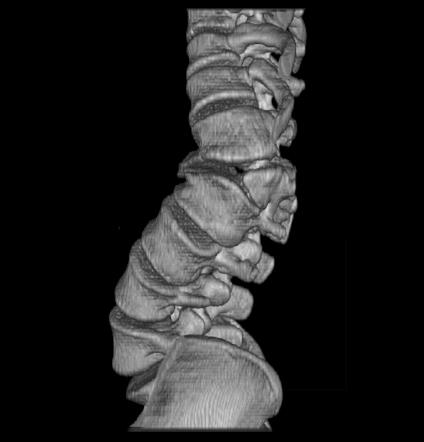A hemivertebra is one of the developmental anomalies of the spinal column. Its incidence has been estimated at 1-10 cases per 10000 births, and affects males more. It often causes congenital scoliosis, and is particularly associated with other health disorders in newborns. This article details the categories of hemivertebrae, diagnosis and management of this condition.
Definition
Hemivertebra is considered a congenital anomaly of the spine. As its name suggests, it refers to an incomplete vertebra resulting from a failure of vertebral body formation. More specifically, the hemivertebra has a single vertebral pedicle, a single lamina, and only half of the vertebral body (shaped like a triangle). This condition mainly affects the dorsal and lumbar vertebrae.
Its appearance is sometimes associated with other abnormalities such as cardiac, cranial, digestive, renal, musculoskeletal disorders (such as Klippel-Feil syndrome), etc. The presence of these anatomical abnormalities appearing together with the hemivertebra constitutes an unfavorable prognosis for the newborn.
The hemivertebra can be separated into various types:
- Lateral: The most common type, it results in a Scoliosis
- Posterior (dorsal): It is the result of a defect in anterior ossification, and results in a dorsal kyphosis
- Anterior (ventral): Extremely rare, it is the result of a posterior ossification defect, and generates a hyperlordose
The hemivertebrae can also be classified based on their growth pattern:
- Segmented hemivertebra: This type of vertebra is completely separated from the adjacent upper and lower vertebrae by an intervertebral disc (like any vertebra). However, it disrupts the alignment of the spine, causing scoliosis in the majority of cases.
- Semi-segmented hemivertebra: This type of vertebra is attached (fused) on the one hand to the adjacent vertebra, and separated from an intervertebral disc with the other adjacent vertebra (unlike normal vertebrae which are separated from discs at the upper and lower level).
- Unsegmented hemivertebra: This vertebra is fused to its two neighboring vertebrae, and has no intervertebral disc space. It is most often found at the thoracic level, and generally does not cause scoliosis.
- Incarcerated hemivertebra
Diagnostic
Hemivertebrae are usually diagnosed whenprenatal ultrasound, although the condition is identified after childbirth in nearly a third of cases.
Physical examination is generally insufficient to detect this abnormality. It is for this reason that medical imaging is essential to establish the definitive diagnosis of hemivertebra (ultrasound, ultrasound, radiography), and to establish the differential diagnosis (such as a butterfly vertebra).
Sagittal and transverse views are examined to verify the integrity of the vertebral bodies and vertebrae, and to assess spinal alignment. A vertebra of reduced size, triangular shape and causing a deviation of the spine is suggestive of a hemivertebra in most cases.
Furthermore, and as mentioned, the hemivertebra sometimes appears with other concomitant anatomical anomalies in various places in the human body. These abnormalities affect the vital prognosis.
Patient Care
The diagnosis of hemivertebrae warrants medical management and surgery in some cases. Indeed, their presence can lead to the development of spinal deformities, such as scoliosis or hyperkyphosis.
Thus, once one or more hemivertebrae are identified on medical imaging, careful evaluation must be performed to identify any coexisting anatomical abnormalities (involving other human body systems).
If hemivertebrae are seen at only one or a few vertebral levels, conservative treatment is typically favored. On the other hand, a surgical resection is indicated if several vertebrae are affected. It should be noted that the impact of the hemivertebra is greatest when it is located at the lumbosacral level.
In extreme cases where severe abnormalities of the spine are observed, associated with life-threatening disorders for the fetus, termination of pregnancy is considered. This decision is made in the light of the medical evaluation, and the consent of the parents.
References
- https://pubmed.ncbi.nlm.nih.gov/27449768/
- https://radiopaedia.org/articles/hemivertebra
My name is Anas Boukas and I am a physiotherapist. My mission ? Helping people who are suffering before their pain worsens and becomes chronic. I am also of the opinion that an educated patient greatly increases their chances of recovery. This is why I created Healthforall Group, a network of medical sites, in association with several health professionals.
My journey:
Bachelor's and Master's degrees at the University of Montreal , Physiotherapist for CBI Health,
Physiotherapist for The International Physiotherapy Center


